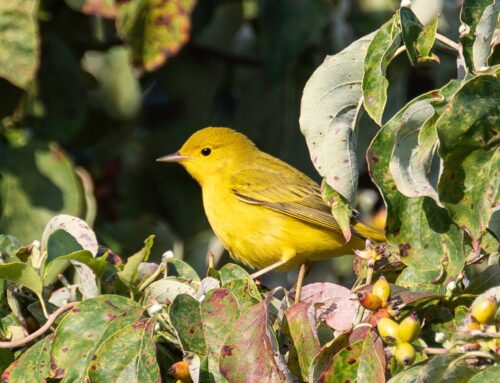Members of the Tyler community may wonder what more they can do to help in the seemingly overwhelming task of tackling climate change, a battle that seems to be sputtering along at best. Participation in a citizen science project offers a fulfilling and fun way for an individual to be part of a larger whole in that fight.
Studying birds turn out to be an effective tool in monitoring the overall health of our environment. By documenting the movements and population changes of different bird species, we can learn a lot about how the larger community of flora and fauna are doing. Like in all living things, bird population health depends on an adequate supply of food and shelter. Seabirds need fish in the water; shorebirds need mudflats full of crustaceans; land birds need insects, seeds, and fruits; raptors need small mammals and other birds to eat. All birds need habitat sufficient for shelter and reproduction. Every one of these relationships is threatened by climate change. A loss or rapid change in any of these components can have an adverse effect on the population of a bird species.
Birds are also pretty and fun to watch, so they can attract large numbers of citizen scientists. The value of bird-related citizen science projects is that they can provide researchers with on-the-ground estimates of the number, density, and movements of different species on a scale that would be unobtainable by professionals alone.
Citizen science targeted to the protection of birds began with the conservation movement of the early 1900s. The first Christmas Bird Count was held on Christmas Day, 1900. There were 27 counts held that year. One was in “Delaware River Meadows, Tinicum Township, Delaware County, Pennsylvania” . Hawk Watching started in the 1930s at what is now Hawk Mountain on the Kittatinny Ridge in Pennsylvania. We now have a nationwide network of mostly volunteer Hawk Watching sites that monitor the spring and fall hawk migrations . Breeding Bird Surveys started in 1966 and are ongoing.
Delaware County has had an active and dedicated birding community involved in these projects since the first CBC in 1900. Tyler Arboretum has fielded teams for the Christmas Bird Count for well over 50 years, and a fall Hawk Watch has been held at Rose Tree Park in Media since 1999.
Now we have eBird. The Cornell Laboratory of Ornithology, in coordination with the National Audubon Society, launched eBird in 2002. Bird watchers could start entering their sightings for each outing in a central database specific to location, date, and time. Importantly, birders were encouraged to count the birds and enter the number of individuals seen, which most birders did not routinely do before eBird. eBird records have become an invaluable data source for researchers worldwide and are now cited in several high-level scientific publications.
eBird currently boasts almost 719,000 eBirders worldwide who have submitted well over 60 million checklists from 253 countries and have documented 10,623 bird species, a number that approaches the total number of species believed to exist in the world. Delaware County can boast 3,008 eBirders, 54,300 checklists, and 345 species on eBird. The richness and accuracy of the database are enhanced by hundreds of dedicated volunteer reviewers who vet all submissions.
eBird encourages participants to include photos, videos, and sound recordings on their lists. This provides more information for researchers and makes the resource more valuable to anyone interested in discovering more about birds and birding.
So check it out. You don’t have to be a birder. An eBird account is free, and much of the information on eBird can be viewed without an account. For example, a person planning to visit Tyler can learn what species are being seen at the Arboretum by checking the Recent Sightings posted to the Tyler eBird hotspot.
A list of all species ever reported to eBird at Tyler Arboretum is available in the Illustrated Checklist. The Illustrated Checklist not only provides a list of reported species but also displays a graph of the time of year that the bird species can be expected, and if available, displays any photos and recordings of the species that were obtained at the Arboretum.
eBird can be a valuable resource for the just curious, an active birder, or anyone in between. If you are interested in birding and have a working ability to identify the common birds of Delaware County, try becoming an eBirder. You don’t have to be an expert, and you don’t have to record every bird you see; only those you can identify with certainty. Every accurate checklist, even if it just contains everyday birds, is valuable. It’s fun, it’s a learning experience, it helps you become more aware of what’s around you, and you will be making a vital contribution to maintaining the health of our planet while you’re at it.
Want to get involved? Join us for our Christmas Bird Count on Saturday, December 17. We are holding two session the Early Session Bird Count from 5:00 – 7:00 am and the morning Christmas Bird Count from 8:00 am to noon.









